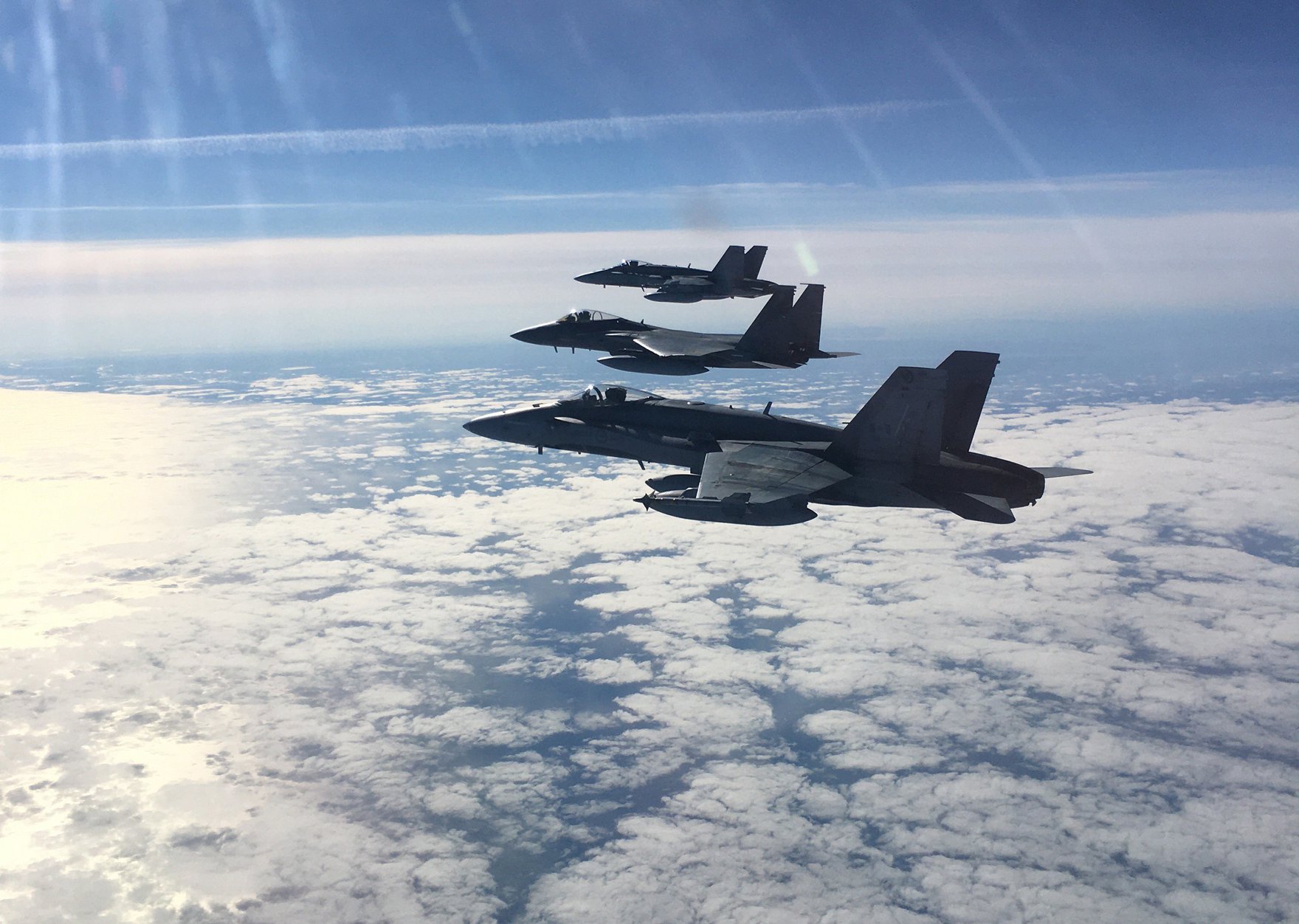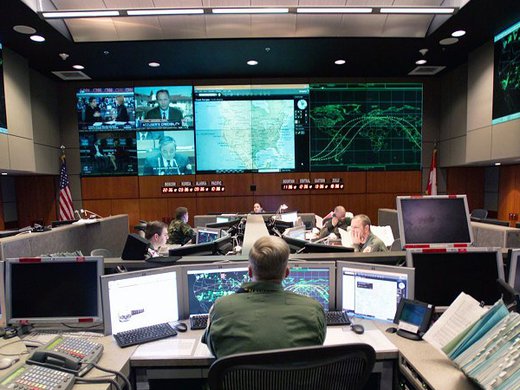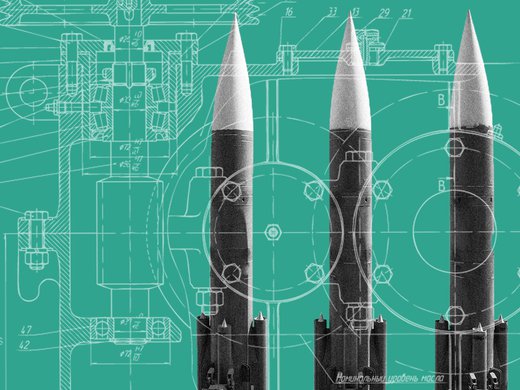Russia’s invasion and assault of Ukraine is a stark reminder to the Western world that democratic allies must work as partners to confront existential threats. This war is a huge wake-up call for governments around the world, including here in Canada.
It’s time to move forward resolutely and quickly on critical defence procurements and infrastructure investments, in particular those that serve the defence of Canada. Key among these efforts is the modernization of the North American Aerospace Defense Command (NORAD). Canada is a full partner in NORAD alongside its neighbour and ally, the United States. We should approach NORAD’s modernization as a partner, not as a subordinate supplier to the United States.
Further, Canada’s contribution to NORAD should align with our key strategic interests and take full advantage of our industrial strengths. Economically, we should focus our efforts in areas where we can press our strategic edge in sustaining key technologies that benefit Canadian industry. Strategically, it’s in our interest to contribute in areas that strengthen both our Arctic sovereignty and our ability to operate in tough Arctic conditions. The best approach is one that allows the Government of Canada to contribute tailored capabilities that are highly valued by both Canada and the United States, within this shared reinvestment.
As clearly articulated by the commander of NORAD and head of US Northern Command General Glen VanHerck, Canada’s existing NORAD defence system, developed in the 1980s and installed in the 1990s, is not equipped to defend Canada from emerging military technology.
While citizens of Western democracies remain glued to their phones watching the vast array of Russian military hardware being deployed in Ukraine, too few of us have paid attention to Russia’s huge recent military buildup in the Arctic.
The North Warning System of radar stations strung like beads along the northern edge of the continuous North American continent was designed to detect aircraft and ballistic missiles attacking North America over the North Pole. This “Maginot Line” is not capable of defending North America from the long-range stealthy Kh-101/Kh-102 cruise missiles developed by an increasingly belligerent Russia, or from the hypersonic missiles recently developed by China and Russia. The insidious cyber and information warfare attacks from a variety of sources also necessitate NORAD modernization.
To be clear, these are not hypothetical future threats. In 2015, Russian government hackers breached the Ukrainian power grid, leading to widespread outages. Russia used Kh-101s against targets in Syria in 2015, 2016 and 2017. In February 2022, in direct support of the Ukrainian invasion, Russia deployed hypersonic missiles in Kaliningrad within striking range of many European North Atlantic Treaty Organization (NATO) capitals. Canada’s defences are inadequate to counter these threats. While citizens of Western democracies remain glued to their phones watching the vast array of Russian military hardware being deployed in Ukraine, too few of us have paid attention to Russia’s huge recent military buildup in the Arctic.
The History of the Soviet Threat in the Arctic
When the Cold War began in the late 1940s, the United States became concerned about the growing threat of long-range Soviet bomber attacks over the North Pole. The Americans sought Canada’s help in continental defence, expanding on existing Second World War defence cooperation agreements. By 1957, top defence officials from both countries had worked out the details; by 1958, the agreement was concluded with the signing of the bilateral North American Air Defense Command treaty. At the time, Canada was developing its own next-generation fighter jet, the Avro Arrow, as an interceptor that could counter the Russian bomber threat. Shortly after signing the NORAD agreement, Canadian Prime Minister John Diefenbaker cancelled the Avro Arrow development project, agreeing instead to procure and deploy US-made Bomarc anti-aircraft missiles, a decision that proved highly controversial since the Bomarcs required nuclear warheads to be effective in their role.
Over the years, the Soviet threat evolved from bombers to include intercontinental ballistic missiles, and NORAD evolved in step, changing its name in 1981 from the North American Air Defense Command to the North American Aerospace Defense Command.
A major modernization in the 1980s, when the Cold War was at its apex, resulted in the North Warning System described above, and the procurement of a new generation of interceptor fighters in both the United States and Canada. A 60/40 cost-sharing agreement between the United States and Canada was established for that modernization — an agreement in place to this day. In the process, Canada procured a fleet of 138 CF-18 fighters, 77 of which are still flying.
In the 1990s, the nature of the threat evolved again, with the advent of cruise missiles. However, with the collapse of the Soviet Union and the end of the Cold War in 1991, defence budgets plummeted, including in Canada. Battling the federal deficit, rather than bolstering defence systems, was top of mind among policy makers.
The period of relative détente came to an end on September 11, 2001, a day that exposed huge vulnerabilities in the defence of North America, with NORAD reduced to tracking hijacked commercial aircraft, after the fact. The modernization of NORAD to address the new threat of cruise missiles never happened, as the focus of national security in both the United States and Canada switched to meeting the threat posed by Osama Bin Laden and al-Qaeda. The disastrous US-led invasion and subsequent occupation of Iraq did little to refocus attention on the defence of North America. But in 2006, NORAD’s mission broadened again — this time with the addition of a maritime warning mission to detect and track threats posed by ships and submarines. That threat continues to evolve and grow, due to Russia’s massive Arctic military buildup, and the rapid rise of China’s naval capabilities and interests. The threats posed by cyber-, information- and space-based weapons are considerable, and growing quickly, and have yet to be seriously addressed within NORAD’s current structure.
All of this explains why, over the past decade, momentum has gradually built toward a further modernization and upgrade of North American defences, via NORAD. This effort has been led by the United States. The Americans have been urgently poking Canada, trying to get us to act as well. So far, they’ve had far too little success.
The first big poke occurred at the first summit between US President Joe Biden and Canadian Prime Minister Justin Trudeau in February 2021, when Biden pressed Trudeau to move forward as a partner. The second prodding came in November 2021, when General VanHerck came to Ottawa to brief top Canadian government and military leaders on emerging threats.
Since then, the United States has made considerable progress in architecting the next-generation NORAD system, through the combined efforts of both military and industry members of the US defence-industrial complex, led by the US defence contractor Lockheed Martin. The Joint All-Domain Command and Control (JADC2) concept is to build a network of sensors (including space-based ones) that provide “all-domain” (air, space, land, maritime, cyber and information) situational awareness; develop a command-and-control system to glean key information from all those sensors; and build on or upgrade existing weapons systems, including warships, aircraft and ground-based missiles, to respond to the threats accordingly. In other words, according to a backgrounder prepared by the US Congressional Research Service, the JADC2 aims “to connect sensors from all of the military services — Air Force, Army, Marine Corps, Navy, and Space Force — into a single network…creating an ‘internet of things’ network that would connect numerous sensors with weapons systems, using artificial intelligence algorithms to help improve decision making.”
Canada has been slower off the mark. The government has acknowledged that NORAD modernization was not contemplated and therefore not funded by its 2017 update to its defence policy, Strong, Secure, Engaged, a gap that’s been described as “the unfinished chapter” of that document. The government has also discussed plans to start up a new, modestly funded research and development program to explore promising relevant technologies. The United States has made it clear that it cannot wait for Canada to get moving on this, and to be fair, the growing threats dictate that it cannot. If need be, it is extremely likely the United States will proceed on its own to implement the conceptual solution it has already defined.
What does that mean for Canada? We believe it means the cost of the 40 percent of that American-designed modernization will be paid by Canadian taxpayers under the terms of our standing cost-sharing agreement. The arrangement can be expected to include a condition that elements of the solution will be built in Canadian branch plants of some US defence subsidiaries (at least until such time that arguments can be made for repatriating the work back to the United States), as is happening today on the Canadian Surface Combatant project.
The Way Forward
We believe there is a win-win solution that both addresses Canada’s bilateral defence needs within NORAD and furthers its industrial development and Northern development goals. Key to the Government of Canada’s Industrial Technology policy is the concept of Key Industrial Capabilities (KICs). Somewhat analogous to the Olympic strategy to “Own the Podium,” the KIC principle is that while Canada can’t master all trades, we should and can master some. So, rather than investing in all defence technologies equally, Canada should focus its efforts where it already has world-class capabilities, and in areas where a domestic capability is essential to our national security.
Again, similar to Own the Podium, Canada’s designated KICs can evolve over time; the current list includes space systems, remotely piloted systems and autonomous technologies, sonar and acoustic systems, and aerospace systems and components, among others. These capabilities are all deemed strategically important and are areas in which Canada leads and could directly contribute to NORAD modernization.
Rather than investing in all defence technologies equally, Canada should focus its efforts where it already has world-class capabilities, and in areas where a domestic capability is essential to our national security.
Space Systems
A key component of a modernized NORAD will be space-based all-domain situational awareness sensors. For example, the Canadian company MDA Systems has been a world leader in satellite-based surveillance systems since it launched the first-generation Radarsat system in 1995. Radarsat-2, which is currently operational, provides all-weather and day/night surveillance, including the detection of ships among ice flows and moving targets on land. MDA is currently developing its third-generation constellation of Radarsat. This could be an appropriate time to offer Canadian companies with established expertise such as MDA new challenges commensurate with the current NORAD threats.
Remotely Piloted Systems and Autonomous Technologies/Sonar and Acoustic Systems
A modernized NORAD must provide for a maritime warning capability, including the ability to detect both surface and submarine threats that could serve as launchers of missiles against North America from the Arctic Ocean north of Canada or from the Northwest Passage (which Canada considers to be Canadian and which the United States considers to be an international strait). This maritime warning mission was not part of NORAD’s original scope. As such, it is not addressed, even in an obsolete fashion, by the current North Warning System. However, Canada has decades of experience and world-class capabilities in subsea surveillance using remotely piloted systems.
Its expertise in this area dates back to the Cold War, when the Defence Research Board, later the Defence Research and Development Agency, teamed up with Canadian industry to provide a game-changing system to monitor submarine traffic in Canadian Arctic waters using a purpose-built autonomous underwater vehicle. Today, Canadian companies compete successfully alongside international multinationals from the United States and Europe in this sector, exporting robotic sonar surveillance systems to allied NATO navies.
If Canada were to take responsibility for this niche in modernizing NORAD, we would ensure that these waterways would be surveilled by Canadian systems and sensors.
Aerospace Systems and Components
Canada is now in the final stages of choosing a next-generation fighter jet, a primary mission of which will be NORAD defence. At this point, the choice has been narrowed to two options: the Lockheed Martin F-35 or the Saab Gripen E.
Given that the area of aerospace systems and components has been recognized and designated as a KIC, we argue that Canada should both maximize the Canadian contribution of the next-generation fighter, and choose the fighter best able to meet the NORAD mission requirements. Canadian contribution considerations include intellectual property (IP) ownership as well as the level of production and in-service support in Canada. Important operational considerations include the fighter’s ability to efficiently and effectively operate from austere Northern airstrips and work interoperably with US fighters, while also offering unique and complementary mission capabilities.
Canada’s Arctic Policy
Other possibilities for upgrading Canada’s defence capabilities present themselves. Just as NORAD modernization is not yet funded as an element of Canada’s defence policy, Strong, Secure, Engaged, Canada’s new Arctic and Northern Policy Framework is not yet funded either. While both create challenges for the government, there is synergy between the two needs, and opportunities for “two-birds-with-one-stone” investments to be made. Two examples follow.
Arctic Telecommunications
A key objective of both NORAD modernization and of the Arctic and Northern Policy Framework is to provide reliable, affordable and secure telecommunications networks for people living in and equipment operating in the High North. Recent commercial developments in low-Earth orbit (LEO) communications satellite technology have spurred a boom in commercial satellite constellation developments, including by Canadian company Telesat. The Government of Canada has just committed a $1.44 billion investment in Telesat’s LEO satellite constellation, Telesat Lightspeed, to help address the civil communications needs in Canada’s North. Could that investment not be further leveraged into having Telesat provide dual-use technology to also address the telecommunications network needs of a modernized NORAD system?
Arctic Mobility
Defending the northern flanks of North America, as well as building and maintaining the elements of a modernized NORAD system, will depend on the continued and improved ability of defence forces and system maintainers to more easily get to and from, and to operate in and across, Canada’s Arctic. This ability is hindered today by obstacles such as a lack of paved airstrips, insufficient fuel and port facilities, and not enough heavy icebreakers, to name a few. Meanwhile, the Arctic and Northern Policy Framework does a good job of documenting our infrastructure deficiencies in the North and lays out clear (albeit unfunded) goals to close the gaps between Southern and Northern infrastructure. Therefore, it would seem to make sense that Canada take responsibility for this crucial aspect of NORAD modernization, and in doing so, address pressing and promised needs of Northern Indigenous peoples.
National Strengths
We propose that Canada work in partnership with the United States to modernize NORAD, aligning its contributions with key strategic niches in which it has a leading strategic capability, and with niches that would enable Canada to also address other national priorities, including key industrial and Arctic development, and sovereignty.
This strategy provides two key benefits.
First, by building on existing strengths, it maximizes the value of Canada’s 40 percent contribution to the binational modernization effort. We can and should “punch above our weight,” and we can and should speed up NORAD modernization, rather than slow it down.
Second, it would significantly support other key national strategic objectives, such as addressing the transportation, energy and communications infrastructure gaps in Canada’s North while respecting Indigenous land claim agreements; maintaining our key strategic industrial capabilities; and exercising our Northern sovereignty.
Simply put, Canada should play to its national industrial strengths in areas such as autonomous space-based and subsea surveillance, while also contributing in areas that could address national and Northern socio-economic and sovereignty needs, such as dual-use Northern communications and transportation infrastructure, all the while safeguarding national sovereignty and the IP needed to support these investments in Canada by Canadians.




